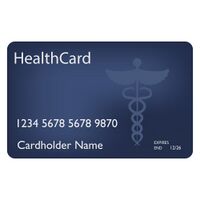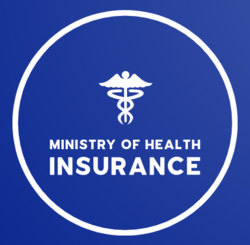Healthcare in Salerit: Difference between revisions
No edit summary |
|||
| Line 57: | Line 57: | ||
== Statistics == | == Statistics == | ||
[[File:Ministry of health insurance.png|250px|thumb|right|Ministry of Health Insurance]] | [[File:Ministry of health insurance.png|250px|thumb|right|Ministry of Health Insurance]] | ||
Heathcare costs in Salerit are 10. | Heathcare costs in Salerit are 10.1% of GDP, being considered a medium-high expense in Anteria. Approximately 91% of the costs were paid through premiums, while the remaining 9% were paid through federal or state grants. The average healthcare expenditure per person was S$2,540 (ACU 2,419) annually, which is considerably higher compared to many Anteria countries. | ||
Salerit has a considerably high density of medical personnel, having 338 doctors and 445 nurses per 100,000 inhabitants. These jobs have salaries above the country's average, averaging S$62,210 (ACU 59,247) annually for doctors and S$40,230 (ACU 38,314) for nurses. 78% of medical personnel work in the private sector (with 60% of the total in for-profit organizations and 40% in non-profit organizations), 14% in state-subsidized hospitals and 8% in those funded by the federal government. | Salerit has a considerably high density of medical personnel, having 338 doctors and 445 nurses per 100,000 inhabitants. These jobs have salaries above the country's average, averaging S$62,210 (ACU 59,247) annually for doctors and S$40,230 (ACU 38,314) for nurses. 78% of medical personnel work in the private sector (with 60% of the total in for-profit organizations and 40% in non-profit organizations), 14% in state-subsidized hospitals and 8% in those funded by the federal government. | ||
Latest revision as of 13:17, 26 November 2023
The healthcare in Salerit is universal and it's regulated by the Ministry of Health Insurance. There are no state-free provided health services, but health insurance is compulsory for all the people living in Salerit (permanent residents, citizens or temporal residents up to 1 year of stay).
Health insurance covers the costs of medical treatment and hospitalisation of the insured. However, the insured person pays part of the cost of the treatment. This is done by an annual deductible, with ranges from S$ 1,060 (ACU 1,010) to a maximum of S$ 10,240 (ACU 9,752) and by applying a co-payment of between 5 and 25% of the total cost of treatment as long as it does not exceed S$ 5,010 (ACU 4,771) annually.
Compulsory coverage and costs
All permanent residents, who are in the country for more than 1 year or who are citizens of Salerit, are required to purchase basic health insurance. When contracting it, insurers must offer the same price to all insured persons, and cannot take into account factors such as age, gender or pre-existing diseases. Insurers cannot obtain economic benefits higher than 2.5% with basic insurance (but they can do it in suplement plans). This system is applied at the federal level (although states can add additional services, but never remove those declared at the federal level). Basic insurance must cover the following aspects:
- General practitioner and specialist doctors.
- Emergency medical care.
- Analysis, x-rays, CT scans and other forms of disease detection.
- Non-esthetic surgeries.
- Medium-long term medical treatments.
- Hospital stay in a shared room.
- Pediatric services and vaccination schedule for children and teenagers.
The insured person pays the insurance premium for the basic plan. If a premium is too high compared to the person's income, the government gives the insured person a cash subsidy to help pay for the premium. Despite the coverage provided by compulsory health insurance, patients must pay the following:
- An annual deductible, with ranges from S$ 1,060 (ACU 1,010) to a maximum of S$ 10,240 (ACU 9,752) depending on the patient's income.
- A co-payment of between 5 and 25% of the total cost of treatment as long as it does not exceed S$ 5,010 (ACU 4,771) annually.
The costs of the premiums vary depending on factors such as the insurance company, the state in which one resides (since these can subsidize the costs), the income received by the person and the additional services contracted (such as complementary medicine, dentist or private rooms in case of hospitalization). There are the following regulated monthly rates:
- S$100 - 150 (ACU 95 - 143) for people over 65.
- S$150 - 378 (ACU 143 - 360) for adults aged 28-65.
- S$80 - 165 (ACU 76 - 157) for youth between 16 and 28 years old.
- S$60 - 128 (ACU 57 - 136) for children and adolescents up to 16 years old.
- S$25 - 89 (ACU 24- 85) for children from families with more than 3 sons.
Unregulated insurance and aditional coverage
All citizens with an annual income of more than S$60,000 (ACU 57,142) will be able to opt for unregulated insurance. This should have the same coverage as basic health insurance, but the price will not be regulated and may be based on factors such as age, gender or pre-existing diseases. Individuals who contract this insurance will receive tax deductions of between 1 to 3% on their salary. If they use the compulsory insurance system, an additional tax of between 0.3 and 10% will be added depending on their income.
Additional coverage is also considered non-regulated insurance, and may be acquired voluntarily. The price will depend on the insurer, the age and medical condition of the patient. It will allow you to have additional medical services, such as a dentist, aesthetic medicine, better rooms in case of hospitalization, etc.
Organization
Salerit's healthcare system is made up of a combination of hospitals subsidized by the federal government, states, and for-profit and non-profit organizations. Each patient has the right to choose which hospital they want to be treated in and who they want to be their primary doctor (taking into account existing restrictions on health insurance). In the event that a patient is treated at a medical center or hospital that is not covered by their health insurance, the latter will pay 100% of the costs of their treatment (unless it is a serious emergency and requires immediate attention, in which case that the insurer must cover the stipulated costs).
All people covered by mandatory health insurance will have a Federal Insurance Card. This will be used to record the insurance each person has, additional insurance, medication prescriptions, medical history, etc. It will also be linked to the patient's bank account, and will allow them to make payments in pharmacies, hospitals, etc. Patients will be able to access their medical data and personal information through the Insurance Card app from their mobile phone, and can also make payments with the card from their device.
People who have unregulated insurance must have, by law, a similar system organized by the insurer. The same actions must be able to be carried out as with the Federal Insurance Card; and its data will be shared at all times with the Ministry of Health Insurance.
Statistics
Heathcare costs in Salerit are 10.1% of GDP, being considered a medium-high expense in Anteria. Approximately 91% of the costs were paid through premiums, while the remaining 9% were paid through federal or state grants. The average healthcare expenditure per person was S$2,540 (ACU 2,419) annually, which is considerably higher compared to many Anteria countries.
Salerit has a considerably high density of medical personnel, having 338 doctors and 445 nurses per 100,000 inhabitants. These jobs have salaries above the country's average, averaging S$62,210 (ACU 59,247) annually for doctors and S$40,230 (ACU 38,314) for nurses. 78% of medical personnel work in the private sector (with 60% of the total in for-profit organizations and 40% in non-profit organizations), 14% in state-subsidized hospitals and 8% in those funded by the federal government.
According to the latest survey carried out in 2021 among the country's population, the health system received a rating of 7.9 out of 10. The best rated aspects were the short waiting lists and the quality of technology in hospitals. The worst were the high presence of co-payments and the cost of over-the-counter medications.
The current health model was implemented in 2005, since previously a non-universal system of non-compulsory private insurance was followed that was financed between the worker and the company. The implementation of universal healthcare brought considerable improvements, such as a drop in mortality rates and a considerable increase in life expectancy, going from 73.54 years in 2000 to 78.95 years in 2021.




